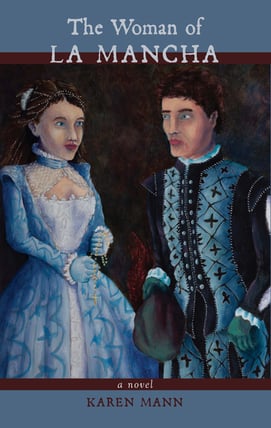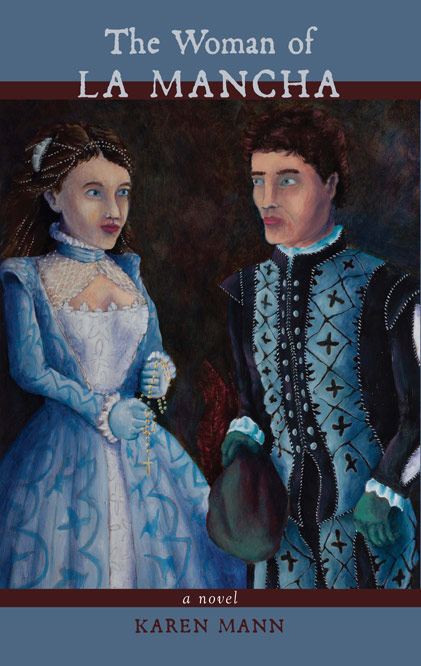By Karen Mann, guest blogger
 The biggest misconception I see in new writers is the notion that once we have a first draft, we’re finished. I see the disappointment on their faces when talking about their first draft and what needs to be revised.
The biggest misconception I see in new writers is the notion that once we have a first draft, we’re finished. I see the disappointment on their faces when talking about their first draft and what needs to be revised.
When I was doing research for The Woman of La Mancha, I happened upon information about a sixteenth-century process of oil painting. Paintings were completed in seven layers, taking seven weeks to dry between each layer. The first layer was a line sketch. Each layer added more color and more detail until at the end, very specific details were added. Notice my book’s cover, an oil painting by AJ Reinhart. The pearls in the woman’s hair and the stitching on the man’s jacket were added last. Necessary and very fine details.
For The Woman of La Mancha I wrote 1,500 manuscript pages, yet the final version was 440 pages. I excised whole sections and re-wrote every part. With each revision, I saw more detail, more life, more vividness come to each scene. It reminded me of what I had learned about oil painting, how the most specific details were added last. I began to value and look forward to revision, knowing in a concrete way that my novel was getting better. My first draft had merely been a foundation on which I could build a book.
How did I know what to revise? I found readers. Choose people who have the ability to express what works and what doesn’t work. Ask your readers to note (right in the margin) where the story doesn’t make sense, where characters seem to act out of character, or where dialogue seems stilted or unrealistic. Where does the story move along, where does it lag, and even where is it boring.
When you get their comments, use them to revise. You will receive comments you don’t agree with. You may feel bothered that the readers “didn’t get it.” But trust that there is something in their comments that will better your book.
If they are confused, fix it. If they don’t understand something, fix it. If they don’t believe your character is acting consistently, fix it. Remember you know the story, and you may have left out details and specifics that would make the story clear to readers. In the end you have the final creative say over your work. Just remember, with each revision your book gets better and more beautiful.
 About the Author:
About the Author:
Karen Mann is the author of The Woman of La Mancha and The Saved Man. She is the co-founder and Administrative Director of the low-residency Master of Fine Arts in Writing Program at Spalding University (www.spalding.edu/mfa) and managing editor of The Louisville Review, a national literary magazine since 1976 (www.louisvillereview.org). Having lived in Indiana most of her life, she now lives in San Jose, California. See more about her books at www.karenmannwrites.com.
About The Woman of La Mancha:
The Woman of La Mancha, a companion book to Don Quixote, tells the woman’s story of Don Quixote by recounting the story of the girl he called Dulcinea, the woman he loved from afar.
It’s 1583. An eleven-year-old girl wakes in the back of a cart. She has lost her memory and is taken in by a kindly farm family in La Mancha. She adopts the name Aldonza. She doesn’t speak for quite some time. Once she speaks, there is a family member who is jealous of her and causes a good deal of trouble, even causing her to be forced to leave La Mancha in tragic circumstances. Having to create a new life in a new location and still unaware of her birth family, she adopts the name Dulcinea and moves in the circles of nobility. While seeking her identity, she becomes the consort of wealthy men, finds reason to disguise herself as a man, and learns herbal healing to help others.
There is a parallel story of a young man, Don Christopher, a knight of King Philip and the betrothed of the girl, who sets off on with a young squire, Sancho, to find the girl. Christopher’s adventures take them across Spain and force him to grow up. Does he continue the quest to find his betrothed or marry another and break the contract with the king?
Both young people have many experiences and grow up before the readers’ eyes. Floating in and out of each other’s paths as they travel around Spain, will they eventually find each other and be together?


Leave Comment